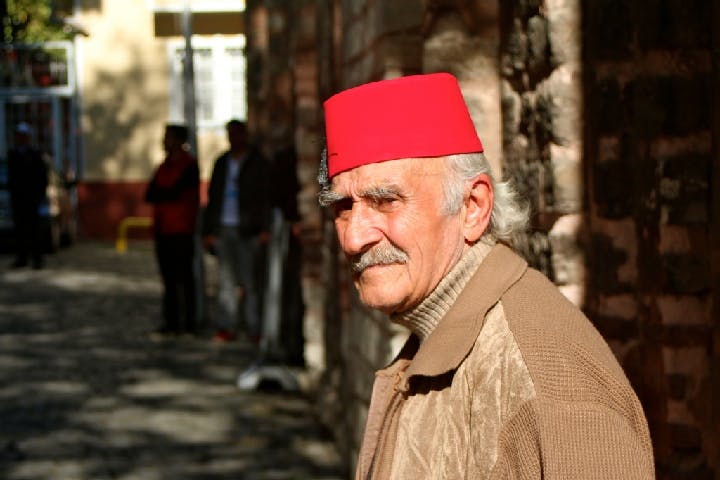The palace, the necktie, and the fez: what aesthetics tell us about Turkish politics
– Carlo Massimo
Looks matter in Turkey. From hats to suits to palaces, aesthetics have always played a crucial role in the Turkish ambivalence toward the West.
“Mere aesthetics.” “Form follows function.” In America, we tend to downplay the way things look. The Turks would beg to differ.
Turkey’s longstanding social tensions have always manifested themselves in table manners and in clothing, in the shape of doorways and in the choice of alphabet. It’s east versus west: a country stuck between the tides of Europe and the Middle East, between secularism and Islam, between liberal nation-state and transnational empire.
Partisans of a liberal, Europeanized Turkey have always pressed for a Turkey that looked liberal and European, favoring Latin letters and business suits over Arabic script and caftans. The opposite tendency looks eastward, toward the conservative Islam of the Middle East and the unique traditions of the Turks. The twenty-first century flag bearer for Turkish conservatism is President Recep Erdoğan, a man whose tastes and aesthetics have long suggested his political tenets. Erdoğan’s Justice and Development Party (AKP) stands not only for Turkish nationalism and business interests, but for conservative Sunni Islam and a rejection of Western tradition.
Nothing articulates this platform better than Erdoğan’s lavish presidential palace. Richly tiled, vast to the point of cavernous, and manned by an army of servants, it houses state offices almost literally within earshot of the presidential apartments. Erdoğan had it built in 2014, but it might well be an Ottoman palace. When Russian President Vladimir Putin visited the palace in December 2014, a phalanx of mounted troopers escorted him through the grounds, like a scene from an epic historical drama. One month later, Erdoğan greeted Palestinian Authority President Mahmoud Abbas with a pageant of guards in old Ottoman costumes, turbaned and armored and jangling with various lethal-looking blades.
It may seem trivial to focus on the aesthetics of Erdoğan’s rule, especially when the issues at stake in the country’s June 2015 elections were so urgent — war in Syria, Turkish-Kurdish relations, high state corruption charges. But a paper by Serap Kavas in the journal Middle Eastern Studies proposes that aesthetics are a useful prism for understanding these issues in modern Turkey. Kavas focuses not on architecture or on military costume per se, but on clothing.
We can start with the fez. For a hundred years, the red fez embodied the Ottoman Empire. From the coffee sellers of Istanbul to the upper ranks of the diplomatic corps, the brimless tasseled cap was ubiquitous. But the fez only came to Turkey in 1826, and carried with it enormous political controversy.
Prior to 1826, headwear in the Empire was not only widely and richly varied, but strictly enforced by law: the civil code allotted a specific type of headdress to every class, ethnicity, and religious group in Ottoman society. Sultan Mahmut II ended this long-enforced tradition by abolishing the old headwear customs and ordering all men to don the fez, a hat of Maghrebi origin that was popular in Egypt, but rare in Turkey.
It may sound historically irrelevant. But the adoption of the fez indicated a fundamental change in the Ottoman Empire. The fez symbolized citizenship, a novel concept in the disjointed, medieval Ottoman autocracy. If Albanians, Kurds, and Georgians wore the same hat as the ethnic Turks, by implication they had the same stake in the national government. Everyone, Turkish or Kurdish, peasant or bureaucrat, was now an Ottoman. It was an idea that disgusted the traditional elites, whose power depended on an empire of subjects, not citizens.
Later in the nineteenth century, the people of Istanbul began discarding the flowing robes of the Ottoman past. Neckties, western-style silverware, and men dancing with women heralded a new era for the Ottoman Empire, presaging the multiparty elections and other liberal reforms of 1908. They also presaged the countercoup of 1909, when students marched on Istanbul demanding not only Turkish supremacy and absolutist government, but restoration of traditional robes and caftans.
The student-cadre of the 1909 coup has a worthy heir in President Erdoğan and the AKP. The AKP’s mission is to steer Turkey away from the West, turning it eastward through strongman politics, Putin-esque energy policy, and by embracing the politicized Islam of the Middle East. Far more vigorously than any European country, the AKP defends the legitimacy of the Muslim Brotherhood.
The AKP does not, however, profess any support for the Islamic State (ISIS). Nonetheless, ISIS does consider itself a caliphate — which would make it the heir of the Ottoman Empire, whose sultan held the title of caliph. And like other heirs of sultans, the Islamic State is famous for its attention to aesthetics, spending a good deal of time managing music, architecture, clothing, and poetry.
It’s worth noting that a souvenir shop has been raising eyebrows for selling Islamic State memorabilia, including flags, t-shirts, key rings, and other tsotchkes. That shop is in Istanbul.
* * *
The Source: Serap Kavas, “‘Wardrobe Modernity’: Western Attire as a Tool of Modernization in Turkey.” Middle Eastern Studies 51.4 (2015) 515-539
Photo courtesy of Flickr/BossTweed
